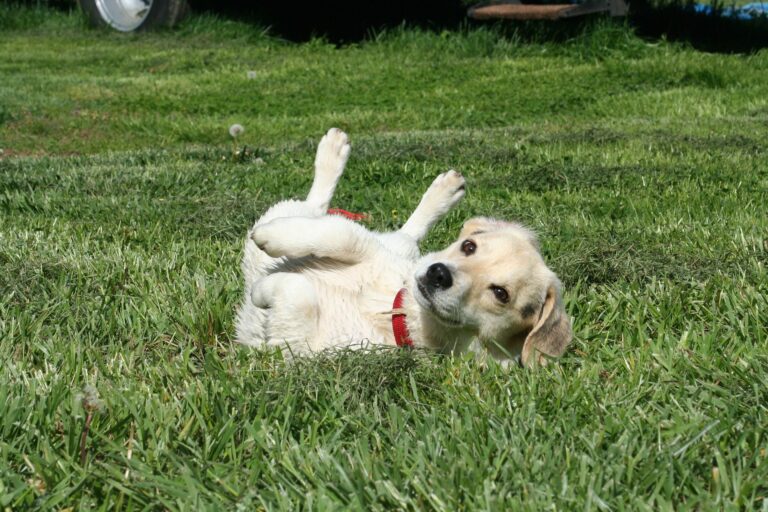If you’re a dog owner, you’ve probably witnessed your furry friend suddenly drop to the ground and start rolling enthusiastically in the grass. While this behavior may seem strange or even amusing, there are fascinating reasons behind it. In this article, we’ll explore the curious habit of dogs rolling in the grass and delve into the possible explanations for this peculiar behavior.
The Grass-Rolling Mystery:
- Scent Camouflage: One of the most widely accepted theories behind why dogs roll in the grass is scent camouflage. In the wild, canines would often roll in strong-smelling substances like animal carcasses or feces to mask their own scent. This behavior helped them approach prey or navigate their surroundings without being detected by potential threats.
- Ancient Instincts: Rolling in grass is a vestige of ancient canine behavior. Domestic dogs still carry many instincts from their wild ancestors, and scent masking through rolling remains a deeply ingrained behavior.
Even though our pet dogs no longer rely on hunting for survival, these instincts persist, and they may roll in the grass as a way of expressing this ancient behavior. - Communication and Bonding: Rolling in the grass can serve as a form of social communication among dogs. When one dog rolls in a particular scent, they may return to their pack or family to share that scent. This behavior can enhance bonding and cohesion within the group.
- Pleasure and Sensory Stimulation: Some dogs roll in the grass simply because they find it enjoyable and stimulating. The texture of the grass against their fur and skin, combined with the scents and sensations, can be pleasing to them.
Dogs have a keen sense of smell, and rolling in various scents in the environment may be a way for them to experience the world on a sensory level. - Cooling Down: In hot weather, dogs may roll in the grass as a way to cool down. The ground can be cooler than their body temperature, and the act of rolling exposes their belly, which is a heat-sensitive area.
- Marking Territory: In some cases, dogs may roll in the grass to leave their scent on an area, marking it as part of their territory. This behavior can be particularly pronounced in unspayed or unneutered dogs.
What Can You Do About It?
- Acceptance and Supervision: In most cases, grass rolling is a harmless and natural behavior. It’s often best to let your dog indulge in this instinctual behavior as long as it’s not causing any harm.
- Flea and Tick Prevention:
Flea and Tick Risks: Fleas and ticks are common external parasites that can infest your dog when they spend time outdoors, particularly in grassy areas. These parasites can attach themselves to your dog’s skin, fur, or even burrow into their coat.- Health Implications: Fleas and ticks can pose various health risks to your dog. These include:
- Flea Allergies: Some dogs are allergic to flea saliva, and even a single flea bite can trigger severe itching, skin inflammation, and discomfort.
- Tick-Borne Diseases: Ticks can transmit diseases such as Lyme disease, ehrlichiosis, and anaplasmosis. These diseases can have serious and long-lasting effects on your dog’s health.
- Anemia: Flea infestations can lead to anemia, especially in puppies or small dogs, due to blood loss from multiple flea bites.
- Preventive Measures: Regularly checking your dog for fleas and ticks is essential, especially after they’ve been rolling in the grass or spending time in areas known to harbor these parasites.
- Consider using preventive measures to protect your dog from fleas and ticks, such as: Flea and Tick Preventive Products: There are various topical, oral, and collar-based preventive products available through your veterinarian. These products are designed to repel or kill fleas and ticks before they can attach to your dog
- Regular Grooming: Brushing your dog’s coat regularly can help you spot and remove any fleas or ticks before they become a problem.
- Environmental Control: Keep your dog’s living environment clean by regularly vacuuming and washing their bedding. This can help reduce the presence of fleas and ticks in your home.
- Lawn Maintenance: Consider maintaining your yard to minimize flea and tick habitats. Regular mowing and removing tall grass, leaf litter, and debris can help create a less hospitable environment for these parasites.
- Consult Your Veterinarian: Your veterinarian is your best resource for guidance on flea and tick prevention. They can recommend the most suitable preventive products for your dog based on their age, size, and lifestyle.
- It’s essential to follow your vet’s recommendations and administer preventive treatments as directed. Consistency is key to effectively protecting your dog from these parasites.
- In summary, the risk of fleas and ticks is a significant concern for dogs who enjoy rolling in the grass, as these parasites are often found in outdoor environments. Regular checks, preventive measures, and consulting with your veterinarian are crucial steps in safeguarding your furry friend’s health and well-being. By taking proactive steps to prevent infestations, you can ensure that your dog continues to enjoy their outdoor adventures without the risk of these pesky parasites.
- Training and Recall: If you’re concerned about your dog’s grass-rolling habit, consider implementing recall training. This can help you call your dog back to you if they start rolling in something unpleasant or potentially harmful.
In conclusion, while the habit of dogs rolling in the grass may appear peculiar to us, it’s rooted in ancient instincts related to scent masking, communication, and sensory stimulation. Embracing this behavior as a part of your dog’s natural instincts and providing supervision when needed is the key to allowing your canine companion to express their true nature while keeping them safe and happy.


